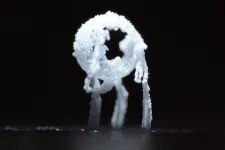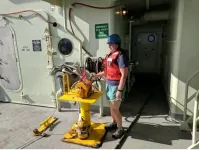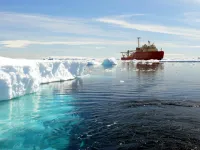INFORMATION:
The work was supported by Equinor through MIT Energy Initiative, the MIT Martin Fellowship Program, and the National Science Foundation.
Written by David L. Chandler, MIT News Office
How to get salt out of water: Make it self-eject
Crystallizing salts can grow 'legs,' then tip over and fall away, potentially helping to prevent fouling of metal surfaces, researchers find
2021-04-28
(Press-News.org) About a quarter of a percent of the entire gross domestic product of industrialized countries is estimated to be lost through a single technical issue: the fouling of heat exchanger surfaces by salts and other dissolved minerals. This fouling lowers the efficiency of multiple industrial processes and often requires expensive countermeasures such as water pretreatment. Now, findings from MIT could lead to a new way of reducing such fouling, and potentially even enable turning that deleterious process into a productive one that can yield saleable products.
The findings are the result of years of work by recent MIT graduates Samantha McBride PhD '20 and Henri-Louis Girard PhD '20 with professor of mechanical engineering Kripa Varanasi. The work, reported in the journal Science Advances, shows that due to a combination of hydrophobic (water repelling) surfaces and heat, dissolved salts can crystallize in a way that makes it easy to remove them from the surface, in some cases by gravity alone.
When the researchers began studying the way salts crystallize on such surfaces, they found that the precipitating salt would initially form a partial spherical shell around a droplet. Unexpectedly, this shell would then suddenly rise on a set of spindly leg-like extensions grown during evaporation. The process repeatedly produced multilegged shapes, resembling elephants and other animals, and even sci-fi droids. The researchers dubbed these formations "crystal critters" in the title of their paper.
After many experiments and detailed analysis, the team determined the mechanism that was producing these leg-like protrusions. They also showed how the protrusions varied depending on temperature and the nature of the hydrophobic surface, which was produced by creating a nanoscale pattern of low ridges. They found that the narrow legs holding up these critter-like forms continue to grow upward from the bottom, as the salty water flows downward through the straw-like legs and precipitates out at the bottom, somewhat like a growing icicle, only balanced on its tip. Eventually the legs become so long they are unable to support the critter's weight, and the blob of salt crystal breaks off and falls or is swept away.
The work was motivated by the desire to limit or prevent the formation of scaling on surfaces, including inside pipes where such scaling can lead to blockages, Varanasi says. "Samantha's experiment showed this interesting effect where the scale pretty much just pops off by itself," he says.
"These legs are hollow tubes, and the liquid is funneled down through these tubes. Once it hits the bottom and evaporates, it forms new crystals that continuously increase the length of the tube," McBride says. "In the end, you have very, very limited contact between the substrate and the crystal, to the point where these are going to just roll away on their own."
McBride recalls that in doing the initial experiments as part of her doctoral thesis work, "we definitely suspected that this particular surface would work well for eliminating sodium chloride adhesion, but we didn't know that a consequence of preventing that adhesion would be the ejection of the entire thing" from the surface.
One key, she found, was the exact scale of the patterns on the surface. While many different length scales of patterning can yield hydrophobic surfaces, only patterns at the nanometer scale achieve this self-ejecting effect. "When you evaporate a drop of salt water on a superhydrophobic surface, usually what happens is those crystals start getting inside of the texture and just form a globe, and they don't end up lifting off," McBride says. "So it's something very specific about the texture and the length scale that we're looking at here that allows this effect to occur."
This self-ejecting process, based simply on evaporation from a surface whose texture can be easily produced by etching, abrasion, or coating, could be a boon for a wide variety of processes. All kinds of metal structures in a marine environment or exposed to seawater suffer from scaling and corrosion. The findings may also enable new methods for investigating the mechanisms of scaling and corrosion, the researchers say.
By varying the amount of heat along the surface, it's even possible to get the crystal formations to roll along in a specific direction, the researchers found. The higher the temperature, the faster the growth and liftoff of these forms takes place, minimizing the amount of time the crystals block the surface.
Heat exchangers are used in a wide variety of different processes, and their efficiency is strongly affected by any surface fouling. Those losses alone, Varanasi says, equal a quarter of a percent of the GDP of the U.S. and other industrialized nations. But fouling is also a major factor in many other areas. It affects pipes in water distribution systems, geothermal wells, agricultural settings, desalination plants, and a variety of renewable energy systems and carbon dioxide conversion methods.
This method, Varanasi says, might even enable the use of untreated salty water in some processes where that would not be practical otherwise, such as in some industrial cooling systems. Further, in some situations the recovered salts and other minerals could be salable products.
While the initial experiments were done with ordinary sodium chloride, other kinds of salts or minerals are expected to produce similar effects, and the researchers are continuing to explore the extension of this process to other kinds of solutions.
Because the methods for making the textures to produce a hydrophobic surface are already well-developed, Varanasi says, implementing this process at large industrial scale should be relatively rapid, and could enable the use of salty or brackish water for cooling systems that would otherwise require the use of valuable and often limited fresh water. For example, in the U.S. alone, a trillion gallons of fresh water are used per year for cooling. A typical 600-megawatt power plant consumes about a billion gallons of water per year, which could be enough to serve 100,000 people. That means that using sea water for cooling where possible could help to alleviate a fresh-water scarcity problem.
ELSE PRESS RELEASES FROM THIS DATE:
Combined recognition strategy allows CAR T cells to kill solid tumors in mice and avoid side effects
2021-04-28
Two teams have created a new generation of highly specific CAR T cells, which safely cleared solid tumors in mice with mesothelioma, ovarian cancer, and the deadly brain cancer glioblastoma while outlasting and outperforming conventional CAR T cell designs. The results suggest these cells could minimize the risk of dangerous side effects and address the traditionally poor performance of CAR T cells against solid tumors in the clinic. CAR T cells are genetically modified human T cells and have shown impressive performance in patients with leukemia. However, CAR T cells don't work as well against solid tumors, as these cancers lack molecular targets that the cells can easily recognize. ...
Category killers of the internet are significantly reducing online diversity
2021-04-28
The number of distinctive sources and voices on the internet is proven to be in long-term decline, according to new research.
A paper entitled 'Evolution of diversity and dominance of companies in online activity' published in the PLOS ONE scientific journal has shown between 60 and 70 percent of all attention on key social media platforms in different market segments is focused towards just 10 popular domains.
In stark contrast, new competitors are struggling to survive against such dominant players, with just 3 percent of online domains born in 2015 still active today, compared to nearly 40 percent of those formed back in 2006.
The researchers say ...
Deep under the ocean, microbes are active and poised to eat whatever comes their way
2021-04-28
The subseafloor constitutes one of the largest and most understudied ecosystems on Earth. While it is known that life survives deep down in the fluids, rocks, and sediments that make up the seafloor, scientists know very little about the conditions and energy needed to sustain that life.
An interdisciplinary research team, led from ASU and the Woods Hole Oceanographic Institution (WHOI), sought to learn more about this ecosystem and the microbes that exist in the subseafloor. The results of their findings were recently published in Science Advances, with ASU School of Earth and Space Exploration assistant professor and geobiologist ...
IPK scientists identify networks for spikelet formation in barley
2021-04-28
Organ development in plants mostly occurs through combinatorial activity of so-called meristems. Meristems are plant cells or tissues that give rise to new organs, similar to stem cells in human - including spikelets. Spikelets are components of the spike and form florets (flowers) themselves, which in turn produce grains after fertilisation.
Inflorescence morphogenesis in grasses (Poaceae) is complex and based on a specialised floral meristem, the spikelet meristem, from which all other floral organs arise and which also gives rise to the grain. The fate of the spikelet thus determines not only reproductive success, ...
National cardiogenic shock initiative results demonstrate increased heart attack survival
2021-04-28
DETROIT (April 28, 2021) - The results of a large, national heart attack study show that patients with a deadly complication known as cardiogenic shock survived at a significantly higher rate when treated with a protocol developed by cardiologists at Henry Ford Hospital in END ...
Uncertainty of future Southern Ocean CO2 uptake cut in half
2021-04-28
Anyone researching the global carbon cycle has to deal with unimaginably large numbers. The Southern Ocean - the world's largest ocean sink region for human-made CO2 - is projected to absorb a total of about 244 billion tons of human-made carbon from the atmosphere over the period from 1850 to 2100 under a high CO2 emissions scenario. But the uptake could possibly be only 204 or up to 309 billion tons. That's how much the projections of the current generation of climate models vary. The reason for this large uncertainty is the complex circulation of the Southern Ocean, which ...
Male bladder cancer vulnerability could lead to a new treatment approach
2021-04-28
A protein variant common in malignant bladder tumor cells may serve as a new avenue for treating bladder cancer. A multi-institution study led by END ...
Improving the way vets care for animals and people
2021-04-28
Veterinarians, pet owners and breeders often have preconceived notions about each other, but by investigating these biases, experts at the University of Arizona College of Veterinary Medicine hope to improve both human communication and animal care.
"Veterinary medicine may require us to treat the patient, but we are unable to improve pet patient outcomes without human client consent and trust. Communication is an essential component of veterinary practice," said Ryane Englar, an associate professor and the director of veterinary skills development for the college. "As an anecdotal example, vets and breeders don't always get along, but there was no research on these subjects. I wondered, what do the groups want and need? If ...
Severe COVID-19 cases can be predicted by new test
2021-04-28
Washington, D.C. - April 28, 2021 - As of April 2021, more than 3 million people worldwide have died of COVID-19. Early in the pandemic, researchers developed accurate diagnostic tests and identified health conditions that correlated with worse outcomes. However, a clinical predictor of who faces the highest risk of being hospitalized, put on a ventilator or dying from the disease has remained largely out of reach.
This week in mSphere, an open-access journal of the American Society for Microbiology, researchers describe a two-step prognostic test that can help predict a patient's response to infection with SARS-CoV-2. The test combines a disease risk factor score with a test ...
Research delves into link between test anxiety and poor sleep
2021-04-28
LAWRENCE -- College students across the country struggle with a vicious cycle: Test anxiety triggers poor sleep, which in turn reduces performance on the tests that caused the anxiety in the first place.
New research from the University of Kansas just published in the International Journal of Behavioral Medicine is shedding light on this biopsychosocial process that can lead to poor grades, withdrawal from classes and even students who drop out. Indeed, about 40% of freshman don't return to their universities for a second year in the United States.
"We were interested ...
LAST 30 PRESS RELEASES:
New science reporting guide published for journalists in Bulgaria
New international study reveals major survival gaps among children with cancer
New science reporting guide published for journalists in Turkey
Scientists develop a smarter mRNA therapy that knows which cells to target
Neuroanatomy-informed brain–machine hybrid intelligence for robust acoustic target detection
Eight SwRI hydrogen projects funded by ENERGYWERX
The Lundquist Institute and its start-up company Vitalex Biosciences Announces Strategic Advancement of Second-Generation fungal Vaccine VXV-01 through Phase 1 Trials under $40 Million Competitive Con
Fine particles in pollution are associated with early signs of autoimmune disease
Review article | Towards a Global Ground-Based Earth Observatory (GGBEO): Leveraging existing systems and networks
Penn and UMich create world’s smallest programmable, autonomous robots
Cleveland researchers launch first major study to address ‘hidden performance killer’ in athletes
To connect across politics, try saying what you oppose
Modulating key interaction prevents virus from entering cells
Project explores barriers to NHS career progression facing international medical graduates
Jeonbuk National University researchers explore the impact of different seasonings on the flavor perception of Doenjang soup
Two Keck Medicine of USC Hospitals named Leapfrog Top Teaching Hospitals
World-first discovery uncovers how glioblastoma tumours dodge chemotherapy, potentially opening the door to new treatments
A fatal mix-up: How certain gut bacteria drive multiple sclerosis
New AI tool identifies not just genetic mutations, but the diseases they may cause
Deep-learning model predicts how fruit flies form, cell by cell
Combination pills for high blood pressure may simplify treatment, improve long-term health
Immune system keeps mucosal fungi in check
Neurons within the brain use simple rules to localize genetic messages
Electrodes created using light
Second-hand gift-giving is a well-deliberated decision
How human interaction drove evolution to make bears less aggressive
National Poll: Few parents offer teens guidance on healthy eating during holiday season
Cannabis derivatives could provide new ovarian cancer treatments
Raising strong yeast as a petroleum substitute
Clues to the origin of hot Jupiters hidden in their orbits
[Press-News.org] How to get salt out of water: Make it self-ejectCrystallizing salts can grow 'legs,' then tip over and fall away, potentially helping to prevent fouling of metal surfaces, researchers find




